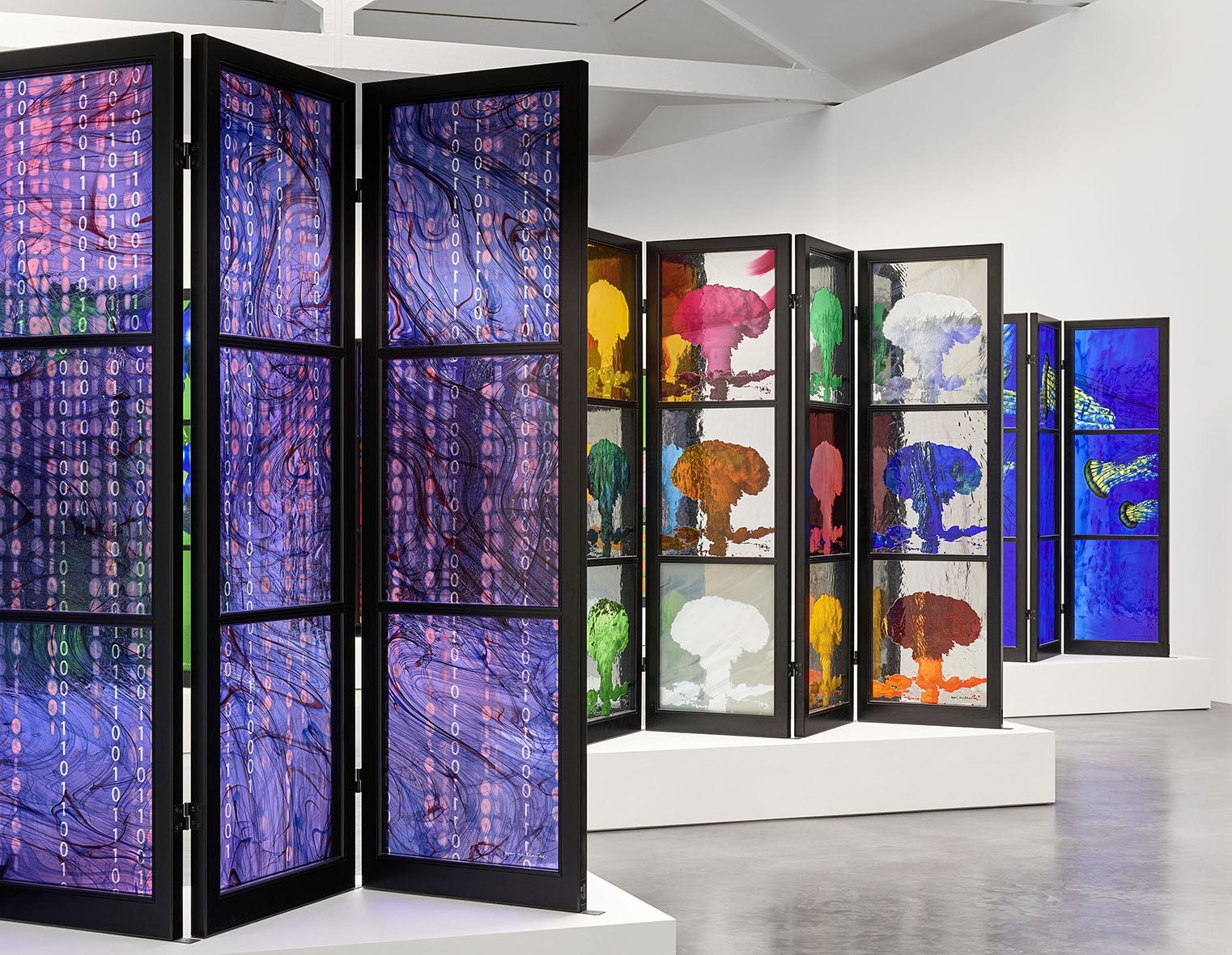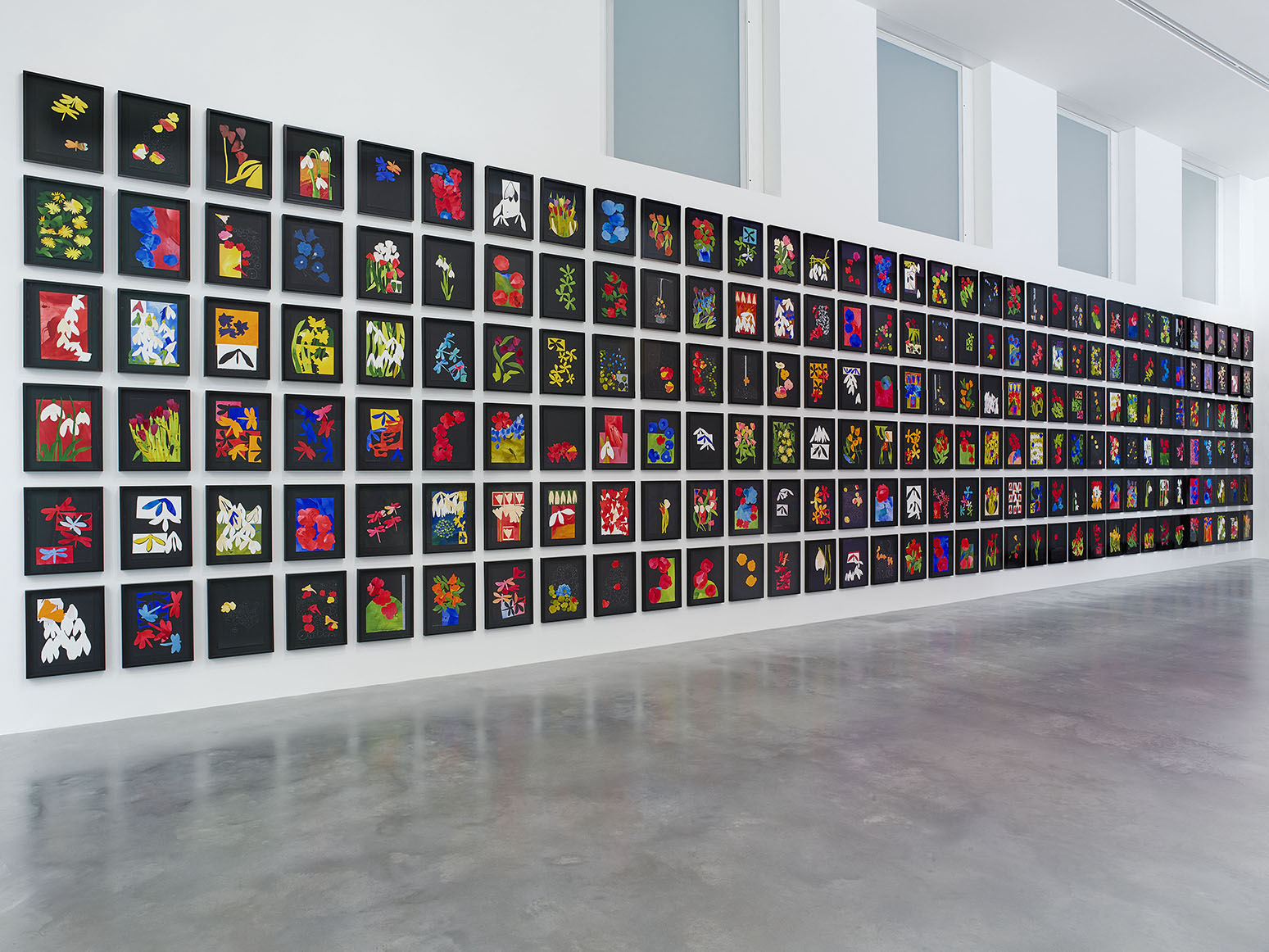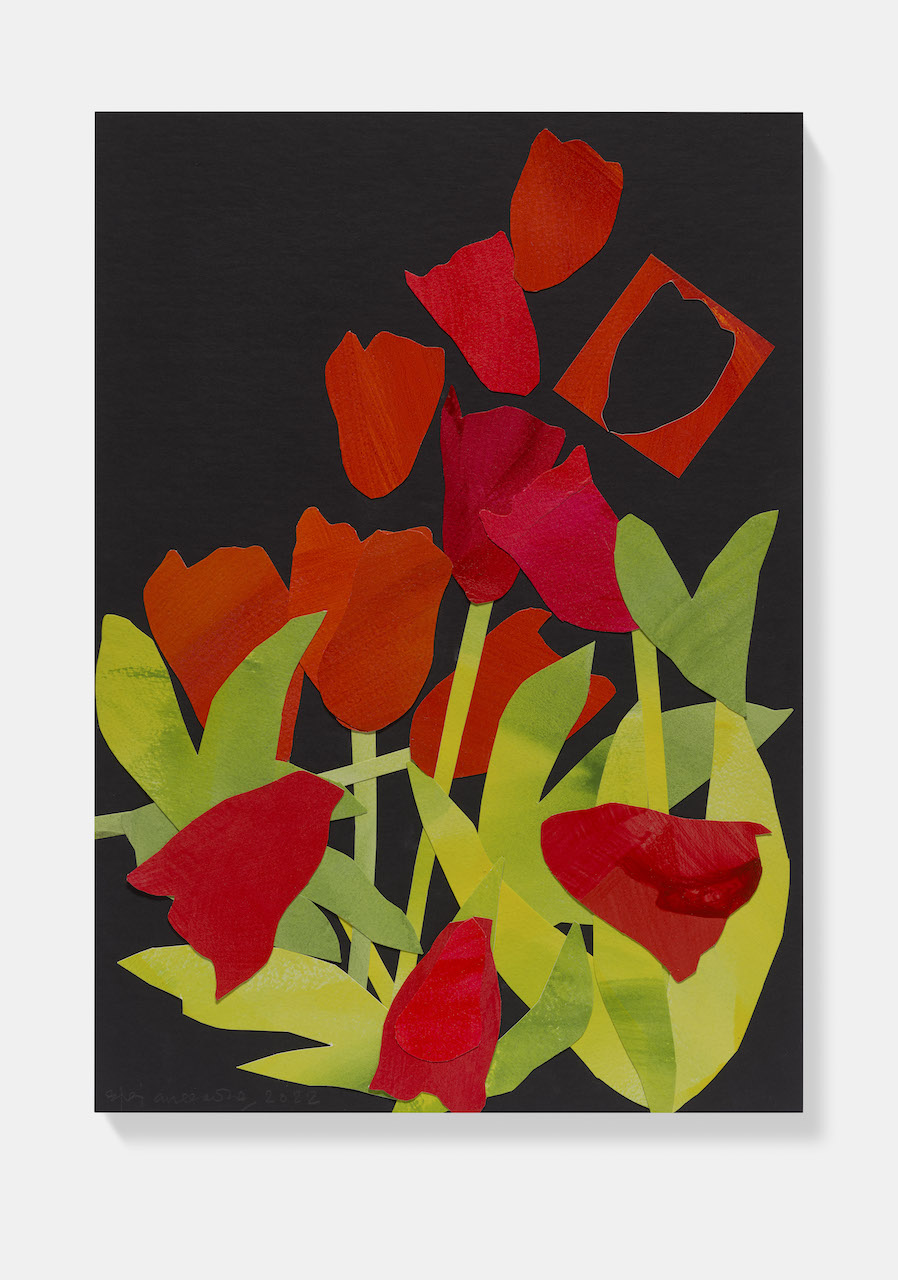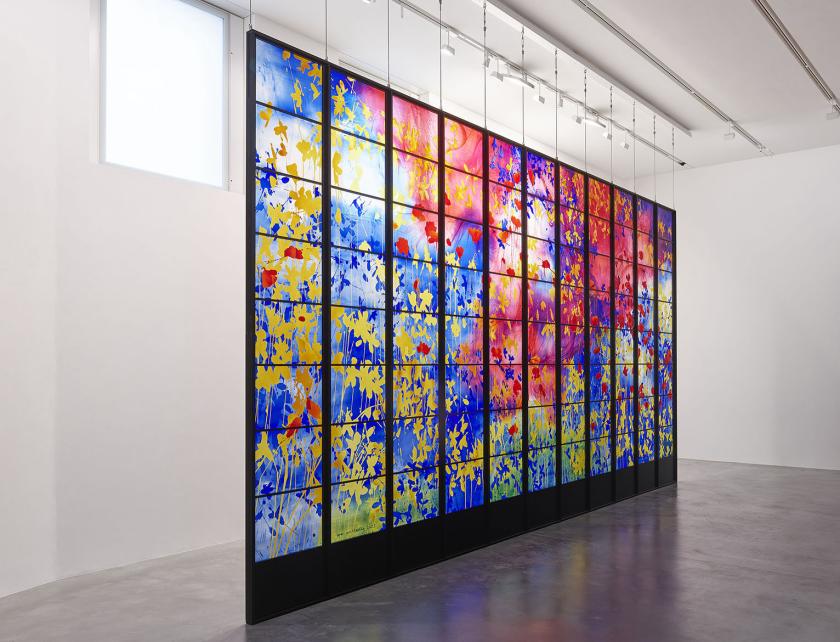The artist Brian Clarke, surely one of the leading British artists of our time, has been all too readily dismissed as a mere craftsman. So much for being an outstanding and highly original painter who’s also done more for contemporary stained glass than any other artist in the world.
His ability to transcend boundaries and follow his own path rather than court marketable fashion and fame, has led to him being side-lined and ignored when he should be celebrated as vigorously as David Hockney and other art world giants of his generation.
He is now the subject of a large exhibition, “A Great Light” – stunning stained glass and immensely inspiring collages – hosted by HENI at Damien Hirst’s spacious South London gallery. The show, even for those who have followed Clarke’s work for decades, is a revelation. The richness of the visual ideas is remarkable and typical of Clarke’s wide-ranging concerns and imagination: from a profusion of life-enhancing colourful blossoms to the menace of nuclear mushroom clouds; from the delicacy of jelly fish to the stern presence of human skulls. At the heart of this marvellously curated exhibition lies a richly paradoxical and deeply stirring juxtaposition of Eros and Thanatos, the energies of life and death, creation and destruction. Brian Clarke, whose passion for the way in which light animates colour and fills space with something intangible and yet very real, began in an adolescent epiphany (as he calls it) – when he was first confronted and filled with awe by the sight and tangible presence of the glass in York Minster. In spite of having being at one time into punk aesthetics, a great deal of playfulness and a refusal to play the game, he’s always been a profoundly spiritual artist. Not because he professes a mission or shouts about his beliefs, but in a way that manifests the creative spirit that animates all the greatest artistic work. Although he works in the context of religious architecture, he isn’t in any way affiliated, only in tune with the essence of spiritual quest.
At the heart of this marvellously curated exhibition lies a richly paradoxical and deeply stirring juxtaposition of Eros and Thanatos, the energies of life and death, creation and destruction. Brian Clarke, whose passion for the way in which light animates colour and fills space with something intangible and yet very real, began in an adolescent epiphany (as he calls it) – when he was first confronted and filled with awe by the sight and tangible presence of the glass in York Minster. In spite of having being at one time into punk aesthetics, a great deal of playfulness and a refusal to play the game, he’s always been a profoundly spiritual artist. Not because he professes a mission or shouts about his beliefs, but in a way that manifests the creative spirit that animates all the greatest artistic work. Although he works in the context of religious architecture, he isn’t in any way affiliated, only in tune with the essence of spiritual quest.
“My grandmother was a medium and spiritualism was the background to my childhood”, Clarke told me revealingly in a documentary I made about him in 2011. “I liked this rather magical, alchemical, weird thing that she brought into my humdrum life. She claimed to be able to see into the future. I was deeply excited by the whole idea of life after death. I was trained as a teenager in spiritualism, but a point came when I had to make a choice: do I continue this interest in spiritualism, or do I go to the really high level of mediumship, which is being an artist?” Ardath (detail above) one of Clarke’s most recent works, is a monumental installation of mouth-blown glass, awash with the interaction of colour and light and displaying a vitality that’s as breath-taking as the masterpieces of Paris’s Sainte-Chapelle. He made his first windows in the North of England at the age of 17, and has never ceased to experiment with the medium, creating luminous commissions for churches, synagogues and mosques as well as shopping centres and airports. This latest piece is the culmination of a lifelong search, and impresses through a remarkable combination of sophistication and simplicity, hallmarks of so much if is best work over the decades. In the next space, and in stark contrast, there is a tall installation of glass featuring a profusion of skulls, a reminder, perhaps that the joy and exuberance of Ardath and its explosion of blossoms, is intimately connected with the cycle of life and death. Further on, the exhibition takes on a journey around the death some years ago of Clarke’s mother, works in which the lead which normally holds the coloured glass panels together takes over as the main feature, until those works when there is only lead – a metal connected with the image of Saturn or Chronos, a figure associated with the inexorable passage of time, and the eventual end of life. In terms of the ancient art of alchemy, lead is essential to the transformation of base metals into gold – all of this imagined symbolically rather than taken literally. Clarke’s very direct evocation of mortality and death is essential to the effervescent celebration of life in so much of his work.
Ardath (detail above) one of Clarke’s most recent works, is a monumental installation of mouth-blown glass, awash with the interaction of colour and light and displaying a vitality that’s as breath-taking as the masterpieces of Paris’s Sainte-Chapelle. He made his first windows in the North of England at the age of 17, and has never ceased to experiment with the medium, creating luminous commissions for churches, synagogues and mosques as well as shopping centres and airports. This latest piece is the culmination of a lifelong search, and impresses through a remarkable combination of sophistication and simplicity, hallmarks of so much if is best work over the decades. In the next space, and in stark contrast, there is a tall installation of glass featuring a profusion of skulls, a reminder, perhaps that the joy and exuberance of Ardath and its explosion of blossoms, is intimately connected with the cycle of life and death. Further on, the exhibition takes on a journey around the death some years ago of Clarke’s mother, works in which the lead which normally holds the coloured glass panels together takes over as the main feature, until those works when there is only lead – a metal connected with the image of Saturn or Chronos, a figure associated with the inexorable passage of time, and the eventual end of life. In terms of the ancient art of alchemy, lead is essential to the transformation of base metals into gold – all of this imagined symbolically rather than taken literally. Clarke’s very direct evocation of mortality and death is essential to the effervescent celebration of life in so much of his work.
The show includes as well installations that occupy space architecturally or three-dimensionally: a collection of his signature screens, featuring a range of subjects from the organic to the political. His “Beach Boys”, large scale portraits of handsome young men in shorts, evoked in a glass technique Clarke developed: without any lead at all, and working with layers of glass on which dot-matrix patterns are printed. Clarke had originally developed this approach while designing large scale windows for Norman Foster and Partners’ Al Faisaliah Centre in Riyadh. These examples of ground-breaking invention, remarkable as they are, are almost upstaged by another installation, a vast and gorgeous assemblage of very recent collages. Perhaps partially in homage to Matisse, an artist whom Clarke especially admires, the rows of 210 collages (pictured above) are some of the most powerful work on display: they fill a whole wall, with a very high ceiling, and their combined visual charge is every bit as stirring as the translucent and giant splendour of Ardath a few feet away. While the whole packs a punch, and a leap of joy in the heart, each image, a perfect and inspired display of coloured shapes on a black background, stands on its own, resplendent and yet utterly unadorned. The works hover on the edge of abstraction (as with so much of Clarke’s work), and yet evoke the essence of petals, leaves and stems. The colour combinations, often daring, are never discordant, as if Clarke were creating – or channelling – a version of nature rich in essence rather than literal imitation.
These examples of ground-breaking invention, remarkable as they are, are almost upstaged by another installation, a vast and gorgeous assemblage of very recent collages. Perhaps partially in homage to Matisse, an artist whom Clarke especially admires, the rows of 210 collages (pictured above) are some of the most powerful work on display: they fill a whole wall, with a very high ceiling, and their combined visual charge is every bit as stirring as the translucent and giant splendour of Ardath a few feet away. While the whole packs a punch, and a leap of joy in the heart, each image, a perfect and inspired display of coloured shapes on a black background, stands on its own, resplendent and yet utterly unadorned. The works hover on the edge of abstraction (as with so much of Clarke’s work), and yet evoke the essence of petals, leaves and stems. The colour combinations, often daring, are never discordant, as if Clarke were creating – or channelling – a version of nature rich in essence rather than literal imitation.
There are many good shows on in London right now, but don’t on any account miss this one. As I walked through the various spaces of this impressive new gallery space, and took in the variety and quality of Brian Clarke’s work, I wondered why he wasn’t as well-known as David Hockney, his host in the gallery Damien Hirst, Cornelia Parker, Anish Kapoor, Tracey Emin, Chris Ofili, Peter Doig, to name just a few artworld stars? He undoubtedly deserves much greater recognition. Could it be that, launched by Robert Fraser, his early work was sold to art-loving rock stars who later became Clarke’s friends? Was he perceived perhaps, by some art critics, as too much of a party animal? Or was it the fact that his work was always linked to architecture, or indeed ‘architectural’ in essence, as he’s claimed, as revealed in his collaborations with Norman Foster, Isozaki and others. Or indeed might there not just be a commonly-held narrow-minded view of stained glass as not being fine art?
On the strength of this exceptional exhibition, it’s worth wondering if it isn’t the spiritual and metaphysical core of the work, at odds with the dominant materialism of contemporary culture, that pushes Clarke to the margins. There are signs, however, that the sense of void and lack of meaning at the heart of our culture is being turned around. It’s no accident that the show’s title refers to “light”. Stained glass is a way of making light present and visible, and Brian Clarke is an artist whose immense talent manifests every aspect of the light within us and without.










![SEX MONEY RACE RELIGION [2016] by Gilbert and George. Installation shot of Gilbert & George 21ST CENTURY PICTURES Hayward Gallery](/sites/default/files/styles/thumbnail_125_x_125_/public/mastimages/Gilbert%20%26%20George_%2021ST%20CENTURY%20PICTURES.%20SEX%20MONEY%20RACE%20RELIGION%20%5B2016%5D.%20Photo_%20Mark%20Blower.%20Courtesy%20of%20the%20Gilbert%20%26%20George%20and%20the%20Hayward%20Gallery._0.jpg?itok=3oW-Y84i)




Add comment